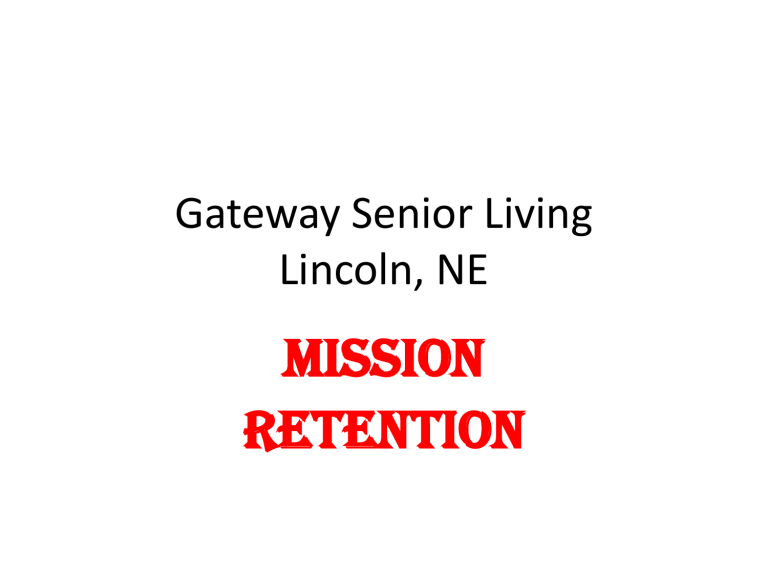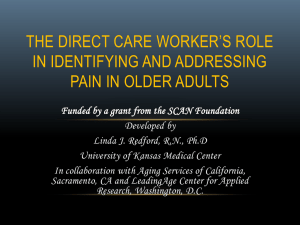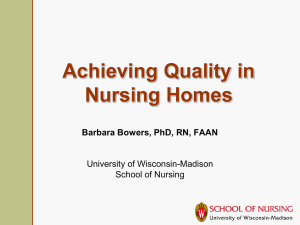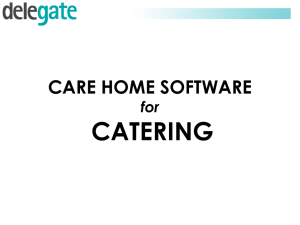Gateway Senior Living Lincoln, NE

Gateway Senior Living
Lincoln, NE
Mission
Retention
A little bit about Gateway
• The first retirement community in the city of Lincoln, built in 1963
• Independently owned by Russell V. Peterson
• Dual licensed: Duplex unit, 54 ALF apartments & 18 SNF beds
• Amy Fish hired in 2007, with 22 years of healthcare administrative experience, licensed preceptor for the state
• 80 staff members: nursing, therapy, dietary, activities, social services, administration, & environmental services
• Participates in the Medicare, Medicaid, and Medicaid waiver programs
• Current occupancy is 98%
Goals of Mission Retention
• Improved orientation to the campus
• Improved training systems
• Enforcement of personnel policies
• Better management of staff & resident needs
• More involvement of direct care staff
• Routine measurement & evaluation of our progress
Day-to-Day Applications of
Mission Retention
• FISH philosophy
• Employee Booster Committee
• Other committees: safety, QA, RSP
• Dish with Fish
• S.H.A.R.E.
• “Are We Meeting Your Expectations”
• “Caught ya Caring” cards & program
• Communication tools: newsletter, caretracker, etc.
• Training programs on teamwork & customer service
• Enforcement of the attendance policy
• Interviewing & Hiring practices
• Impromptu moments & celebrations
Outcomes
•
•
Balanced Scorecard Measurements:
Turnover statistics
Staff Satisfaction Survey questions:
Overall Satisfaction
Quality of Teamwork
Quality of Inservice Education
Recommendation for job
Recommendation for care
Staff to Staff Communication
Safety in the Workplace
Turnover:
Dietary
NA/MA
Statistics
2008
95%
159%
2009
61%
50%
Staff Satisfaction Survey return rate:
2008 37%
2009
2010
63%
89%
2010
38%
50%
At the End of the Day
It’s Really Very Simple…….
and doesn’t cost a lot!
Maintaining Higher Occupancy -
A joint program to increase resident's length of stay by managing difficult behaviors.
Kathy Pietrocola
Executive Director
The Chelsea at East Brunswick
Mission Possible: Changing Culture,
Changing Practice, Changing Care.
A joint venture with NJ Geriatric Education
Center, the NJ Division of Mental Health
Services and the Department of Health and
Senior Services
Purpose of program
–
–
– to enhance overall capacity to better serve those in our care to develop a site specific behavioral management plan to increase resident length of stay
Our initial interest in the University
Behavioral Health Program:
We have two programs that we felt could benefit from an innovative team approach.
– The Country Cottage – Dementia Program
– The Crossings Program – unique to assisted living designed for residents with a psychiatric diagnosis.
Goals for our involvement:
to maintain higher occupancy and length of stay by creating unique approaches to challenging care needs to try new approaches for challenging behaviors rather than medication alone to decrease instigating triggers to provide individualized care by increasing staff awareness to create alternative responses to resistant behavior to foster a staff “buy in” to the concept that some behaviors can be changed/avoided with proper early interventions and approach
Team approach
We attended the meeting as a team:
Exec Dir, RN, Cottage Dir, Certified
Medication Aides and CNAs
Met as a group during our training to decide what our focus would be and we decided our dementia program would be our starting point
Know your resident
The Cottage Director took photos of each cottage resident and put them in a photo album.
She then created a “getting to know you” sheet about each person.
These sheets were then placed on the opposite side of the resident’s picture in the photo album.
All staff was required to read over the information and get to know the residents in a new way.
Selecting our first residents
As a group, we selected residents we felt had specific behaviors we could address.
– Resident #1 had lived in our AL community for years and had been transferred to the Cottage.
– Resident #2 was new to our community and was directly admitted to our Cottage.
Resident #1-
Targeted behaviors-
– unstable wandering
–
– touching (and often ripping) anything within her reach
– limited focus
Targeted approaches – sensory table with sensory videos
–
– sensory boxes staff awareness
Resident #2
Targeted behaviors-
– exiting the secured area
– extremely difficult to redirect
– very limited verbal skills
Targeted approaches –
– creation of the “Walking club”
Walking Club
Our results after two weeks
Resident #1
–
–
– was calmer had periods of engagement with the sensory boxes increased staff interactions
Resident #2
– responded well to the walks
– less exit seeking behavior
Resident #1 and #2 today
Resident #1 just recently moved to a nursing home with overall physical decline and a need for 24 hour nursing supervision. We were able to keep her in our community six months longer using the new techniques and methods.
Resident #2 is doing well. Continues to participate in the walking club and is overall, more content. There is no longer a discussion of not being able to care for him in our community.
Ongoing efforts
As with any new program, change is constant so we continue to adapt our plan using new interventions.
What works this week may not next week.
We currently have two new residents who are sundowning with extreme agitation, and we are now looking at options to avoid the triggers for them.
Looking to the future . . .
New ideas we feel may be successful-
–
Creating a “Sensory Aide” position.
responsibilities will include:
–
–
– ensuring that the sensory plans are carried out each day maintaining the equipment for the program training new aides
– Expand program to The Crossings
Create interventions for:
–
– social isolation anxiety
– lethargy
Creating real life-changing transformation for nursing home residents and staff since 1994
What is Wellspring
A quality improvement program that:
fosters culture change (e.g., residentdirected care, staff empowerment, a homelike environment)
assists participating senior care organizations through ongoing education and support
Wellspring History
Launched in 1994 in Wisconsin as the
Wellspring Innovative Solutions for
Integrated Health Care
Was one of the first efforts to affect culture change
Has assisted nursing homes throughout the country in advancing excellence in their settings
Now part of The Beacon Institute
Core Principles
Care decisions need to take place at the level closest to the resident
A substantial knowledge base is required by all staff to equip them to participate in decision making
An empowered workforce increases resident and employee satisfaction and reduces staff turnover
Why Wellspring?
Customized Programming
Recognizing that every nursing home is different in terms of its staff, resident population, physical plant, resources, and other factors, Wellspring tailors implementation strategies to enable a nursing home to participate in Wellspring regardless of where they are on their journey of culture change.
Why Wellspring?
Affordable
There is no need to make expensive changes to the physical environment or invest large sums of money. There are options to participate in Wellspring for every budget.
Wellspring Achieves Results
Research has demonstrated that Wellspring:
improves the quality of care, resident satisfaction, employee satisfaction
helps to reduce pressure ulcers, falls, incontinence, weight loss, restraint usage, immobility, and psychotropic drug use in residents
increases resident and staff satisfaction
Wellspring Education
Workshops address Best Practices and timely topics:
Culture Change 101
Culture Change Nurse Coordinato Preparation
Leading Culture Change
Leadership for Frontline Staff
Observing and Understanding the Older Adult
Best Practices in Elimination and Incontinence Care
Nutritional Needs from a Holistic Perspective
Restorative Care for Falls Prevention
Best Practices in Pressure Ulcer Prevention, Identification, and
Treatment
Best Practices in Caring for Persons with Dementias
Holistic Palliative Care
Best Practices in Infection Control
Others…
Wellspring Education
But dynamic classroom instruction isn’t all…
Wellspring has developed strategies to assist with the most challenging aspect of education: real life implementation
Wellspring Program Options
There are a variety of ways that a nursing home can participate in the Wellspring
Program based on their unique characteristics, budget, and progress on their culture change journey
Wellspring Program Options
Culture Change Launch Program
Consists of:
Onsite presentation of three full day educational programs:
Culture Change 101
Culture Change Nurse Coordinator Preparation
Developing Best Practice Teams
The nursing home is responsible for proving the site for the program, participant food, an LCD projector, and reproduction of handout materials.
Nurse consultation via email for one year
The monthly Wellspring e-letter and updates for one year
Wellspring Program Options
Alliance Member
An Alliance consists of 8-10 nursing homes that are located within several hours’ driving distance of each other. The Alliance members contract to be part of the Alliance and:
Participate in the same Wellspring educational modules
Receive nursing consultation by the same nurse consultant(s)
Each have a staff person designated as their Wellspring
Coordinator who networks and participates in meetings with other Alliance Coordinators
Input monthly data using My InnerView which is compared among Alliance members
Receive the monthly Wellspring e-letter and updates
Wellspring Program Options
Individual Wellspring Workshops and Consultation Services
An individual nursing home can purchase educational programs and consultation based on individual needs without committing to the full implementation of the
Wellspring model.
The Business Case for Wellspring
Wellspring is an investment which leads to increased efficiencies resulting in cost savings and enhanced revenue.
Research shows that among Wellspring’s benefits are reductions in resident falls, pressure ulcers, incontinence, and staff turnover.
The Business Case for Wellspring
Consider the following costs:
$4,000+ Turnover cost for one nursing assistant
$15,000+ Turnover cost for one nurse
$5,300+ Nursing home added expense related to a fall
$11,000 Treatment of facility acquired pressure ulcer
$4,000 Annual cost for incontinence care per resident
$2,000 One day consultant visit to address a problem
Just one occurrence of each of the above could cost $41,300 , in addition to the nonfinancial costs that result (reputation, morale, poor ratings, etc).
This is several times what it would cost to implement the full
Wellspring Program.
Invest in Your Future!
Join the leaders who improved the quality of care & life for residents, and the quality of work for employees by implementing
The Wellspring Program
Contact
Sandy Douglass, CEO/Administrator
The Methodist Home of DC www.methodisthomeofdc.org
sdouglass@methodisthomeofdc.org
202.777.3301
For more information…
Isabella Firth
Beacon Institute President
410-381-1176 ifirth@lifespan-network.org
Charlotte Eliopoulos
Wellspring Executive Director
410-665-2158 charlotte@HealthEd.net
Wellspring web site: http://www.WellspringProgram.org






